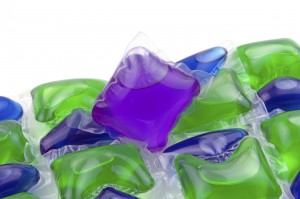 Children are attracted to anything colorful, especially if it looks like candy. And those colorful detergent pods we use to clean laundry and dishes can look very appetizing. In fact, they look just like candy or juice; they’re individually wrapped, are brightly colored, and come packaged in what looks like a candy jar. It’s no wonder that children want to taste them.
Children are attracted to anything colorful, especially if it looks like candy. And those colorful detergent pods we use to clean laundry and dishes can look very appetizing. In fact, they look just like candy or juice; they’re individually wrapped, are brightly colored, and come packaged in what looks like a candy jar. It’s no wonder that children want to taste them.
We all know any laundry detergent is harmful if swallowed, but these individually wrapped pods can be especially caustic because of their contents. Unlike regular powder detergent, the single-use pods are filled with highly concentrated detergent, which is then wrapped in a plastic covering that dissolves when exposed to water or saliva. When swallowed, these pods can cause almost immediate distress, and the effects can be far worse than that of regular detergent.
Symptoms of pod exposure can include vomiting, coughing or choking, a mental status change and respiratory distress. On several occasions, children have been hospitalized and had to be put on a ventilator or intubated to help them breathe.
Exposure to these pods is on the rise. According to the American Association of Poison Control Centers (AAPCC), there were 16,738 laundry packet exposures (in children 5 and under) reported to Poison Centers between 2012-2013 combined. Already, in the first 7 months of 2014, there have been 9,935 reported cases of children 5 and under being exposed to the single-load laundry packets.
Below are some safety tips to follow if you use the more convenient, single-use detergent pods:
- If you have small children then it’s best to use powder detergent. It’s not as attractive to children and the injuries are usually less severe should a child be exposed to it.
- If you use Single-use pods then be sure to seal them tightly and store them in a high place, out of reach and sight of children. It’s best to keep them in a locked cabinet.
- If you use the pods, be extra vigilant about where you set them down. Don’t set them down within reach of a child for even a second. It only takes one second for a child to grab it and bite it, which is all it takes to poison the child, or cause burns to their face or mouth.
Below are tips for what to do if you suspect exposure:
- If the pod is in a child’s mouth, remove it immediately
- Gently wipe the child’s mouth
- Wash the child’s face and hands (to prevent them from spreading it on their face or getting it in their eyes).
Call your Poison Control Center immediately at 1-800-222-1222.
